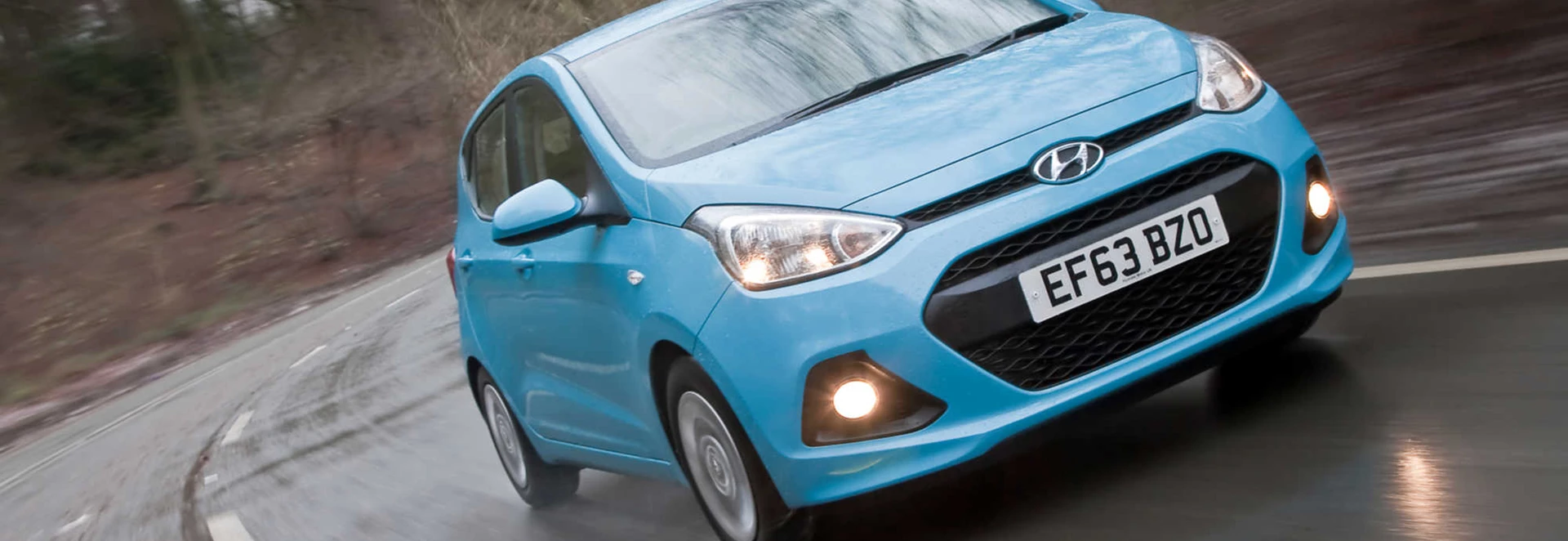The city car segment isn’t unchartered territory for Hyundai, but the previous generation i10 was overshadowed by superior city cars.
Still, the former i10 certainly helped elevate Hyundai sales largely thanks to the scrappage scheme – which subsidised a new car purchase if the owner scrapped an older car – and helped more value carmakers such as Hyundai.
The latest-generation i10 shows that the brand is serious about making its supermini a credible choice in a marketplace which has become saturated in recent years with the VW up!, Skoda Citigo and SEAT Mii to name a few.
Those looking for a nippy car to drive locally and around the city would be best suited to the Hyundai i10.
Performance
The 1.0-litre unit isn’t massively impressive when it comes to power, with just 65bhp on tap. Its 62mph sprint time is also quite predictable, at 14.9 seconds. Although the i10’s performance figures aren’t great, they easily match its equivalent competitors.
Just bear in mind, as power is quite subdued in the three-cylinder, you will find yourself working up and down the gears when it comes to overtaking on the motorway.
Rivals like the VW up!, Skoda Citigo and SEAT Mii are slightly faster in the 0-62mph sprint, with equivalent models able to drive from zero to 62mph in a quicker 14.4 seconds.
As well as the 1.0-litre unit, the i10 is also available with a more powerful 1.2-litre engine, offering 86bhp. This version of the i10 is noticeably quicker than the 1.0-litre variant.
The 1.0-litre unit is mated to a five-speed manual gearbox, while the bigger 1.2-litre powerplant is offered with the choice of the manual ‘box and a four-speed automatic transmission.
Ride and Handling
Generally, compared to rivals such as the Citigo or Mii, the i10 is more adaptable to a range of driving situations, making it a sound choice.
The light steering of the i10 is great for driving around town, making manoeuvres easy. It’s still not as adept as the Volkswagen up!, however, when it comes to city driving. When you venture out away from urban sprawls, the i10 handles itself really well on winding roads, grabbing the road on corners with minimal body roll. Ride comfort is also impressive and is much like that of a bigger car. Generally, compared to rivals such as the Citigo or Mii, the i10 is more adaptable to a range of driving situations, making it a sound choice. Noise in the cabin – of lack of, for that matter – is another clear advantage of the i10 over its competitors. Hyundai has specially focused on insulating the cabin better and therefore reducing wind and engine noise.
Interior and Equipment
The Hyundai i10 was named CarBuyer’s ‘Car of the Year’ and ‘Best City Car’ in 2014.
Hyundai has struck a great balance between affordable plastics and soft touch materials. This balance gives the interior a comfier and more luxurious feel that won’t hurt the bank. Most city car buyers will go for the mid-range SE trim that we tested. This is because it comes equipped with all the major essentials like remote central locking, climate control and electric windows. The i10 offers plenty of space in every department, be it front occupant, rear occupant or even cubby holes. Compared to the previous i10, rear space is much better, with three passengers able to fit without complaint. Where it really stands out is its boot space. Although it trumps the VW up! by just one litre with the seats up at 252 litres, the i10 comfortably exceeds the up!’s storage space with the seats down by almost 100 litres, with a total of 1,046 litres available. This boot space makes it the biggest in the class.
Cost
Priced from £8,595, the Hyundai i10 is slightly cheaper than the VW up! (£8,765) but more expensive than the Skoda Citigo (£8,210) and SEAT Mii (£8,195).
Priced from £8,595, the Hyundai i10 is slightly cheaper than the VW up! (£8,765) but more expensive than the Skoda Citigo (£8,210) and SEAT Mii (£8,195). Although the 1.0-litre three-cylinder options in the i10 range emit as little as 98g/km, the 1.0-litre 65bhp SE model we tested emitted 108g/km. This is mainly due to the added kit, which isn’t unusual with city cars. Regardless of CO2, the i10 still manages to return between 45 and 65mpg across its range – with the model we tested returning just over 60mpg. The likes of the VW up! will emit as little as 95g/km, while returning up to 68.9mpg. Leasing costs will be low as it is a city car, while fleet owners will be attracted by the sub-100g/km CO2 version of the i10. On average, the new i10 will retain 50% of its value over three years/30,000 miles.
Our Verdict
Hyundai has managed to iron out the biggest gripes of its predecessor, making it an all-round great city car that trumps most of its competition. At £8,595, the i10 sits a few hundred pound cheaper than the VW up!. Hyundai’s five year warranty may also convince you to take a closer look at this city-car delight. Whether you’re making short or long journeys, the i10 is a great choice. While found slightly wanting on motorways, the comfort and space within will make journeys easier for both drivers and passengers.




